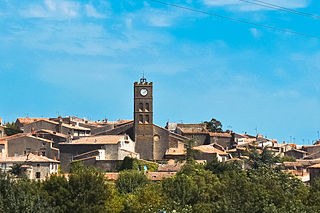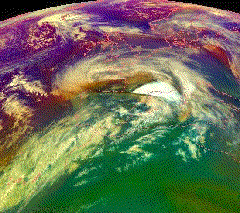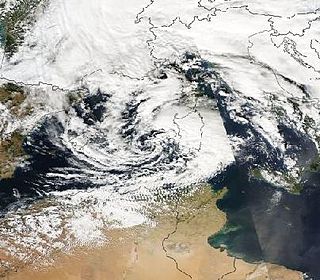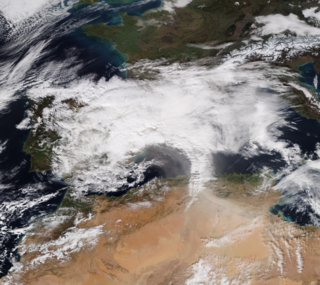
The Aude is a river of southern France that is 224 kilometres (139 mi) long. Its source is in the Pyrenees mountains then runs to Carcassonne and finally reaches the Mediterranean Sea near Narbonne. The river is navigable by raft or canoe for nearly all of its length. It is registered as essential to the Languedoc-Roussillon region.

Conques-sur-Orbiel is a commune in the Aude department in southern France.

Cyclone Xynthia was an exceptionally violent European windstorm which crossed Western Europe between 27 February and 1 March 2010. It reached a minimum pressure of 967 mb (28.6 inHg) on 27 February. In France—where it was described by the civil defence as the most violent since Lothar and Martin in December 1999—at least 51 people were killed, with 12 more said to be missing. A further six people were killed in Germany, three in Spain, one in Portugal, one in Belgium and another one in England. Most of the deaths in France occurred when a powerful storm surge topped by battering waves up to 7.5 m (25 ft) high, hitting at high tide, smashed through the sea wall off the coastal town of L'Aiguillon-sur-Mer. A mobile home park built close to the sea wall was particularly hard-hit. The sea wall was about two hundred years old, built in the time of Napoleon; critics said that situating a mobile home park so close to the sea wall showed poor coastal development practices. The storm cut power to over a million homes in France and a million customers in Portugal lost power.

The 2010 Var floods were the result of heavy rainfall in southern France that caused severe floods in the department of the Var in the evening of 15 June 2010. As well as generalized flooding, there were also flash floods. Meteorologists say the floods are the worst in the region since 1827, with more than 400 mm (16 in) of rain falling in less than 24 hours. At least 25 people were killed. The worst hit municipalities were Les Arcs, Figanières, Roquebrune-sur-Argens, Trans-en-Provence, and the subprefecture of Draguignan.

The 2018 Atlantic hurricane season was the third in a consecutive series of above-average and damaging Atlantic hurricane seasons, featuring 15 named storms, 8 hurricanes, and 2 major hurricanes, which caused a total of over $50 billion in damages and at least 172 deaths. More than 98% of the total damage was caused by two hurricanes. The season officially began on June 1, 2018, and ended on November 30, 2018. These dates historically describe the period in each year when most tropical cyclones form in the Atlantic basin and are adopted by convention. However, subtropical or tropical cyclogenesis is possible at any time of the year, as demonstrated by the formation of Tropical Storm Alberto on May 25, making this the fourth consecutive year in which a storm developed before the official start of the season. The season concluded with Oscar transitioning into an extratropical cyclone on October 31, almost a month before the official end.

Tropical Storm Rolf, also known as Tropical Storm 01M, was an unusual Mediterranean tropical storm that brought flooding to Italy, France, Spain, and Switzerland in November 2011. Rolf originated from an extratropical system near western France on 4 November. Despite the generally unfavorable conditions in the Mediterranean Sea, Rolf transitioned into a subtropical depression on 7 November, before becoming a tropical storm later that day. On 8 November, Rolf reached its peak intensity, with 1-minute sustained winds peaking at 85 km/h (53 mph) and a minimum central pressure of 991 mb (29.3 inHg). During the next day, the storm made landfall on the island of Île du Levant, in France, and soon afterward, near Hyères in southeastern France. Following its second landfall, Rolf quickly weakened and dissipated on 10 November. Rolf was the first tropical cyclone ever to be officially monitored by the NOAA in the Mediterranean Sea.

The 2013 Sardinia floods took place in and around the Sardinian town of Olbia between 17 and 19 November 2013. They also affected other parts of northeastern Sardinia and killed at least 18 people. Thousands of people were left homeless. The places which suffered the most damage were Olbia, and in general the whole region of Gallura. The flood caused damages of over 1 billion euro.

In late May and early June 2016 flooding began after several days of heavy rain in Europe, mostly Germany and France, but also Austria, Belgium, Romania, Moldova, Netherlands and the United Kingdom. Among others, the German states of Bavaria, Hesse, Rhineland-Palatinate, Baden-Württemberg, and North Rhine-Westphalia were affected. Beginning at the river Neckar, the Danube, Rhine, Seine and their tributaries were highly affected by high water and flooding along their banks. At least 21 people died in the floods.
The 2018–2019 European windstorm season was the fourth instance of seasonal European windstorm naming in Europe. Most storms form between September and March. The first named storm, Ali, affected primarily the United Kingdom and Ireland on 19 September 2018.

Hurricane Leslie, while extratropical, was the strongest cyclone of tropical origin to strike the Iberian Peninsula since 1842. A large, long-lived, and very erratic tropical cyclone, Leslie was the twelfth named storm and sixth hurricane of the 2018 Atlantic hurricane season. The storm had a non-tropical origin, developing from an extratropical cyclone that was situated over the northern Atlantic on 22 September. The low quickly acquired subtropical characteristics and was classified as Subtropical Storm Leslie on the following day. The cyclone meandered over the northern Atlantic and gradually weakened, before merging with a frontal system on 25 September, which later intensified into a powerful hurricane-force extratropical low over the northern Atlantic.

The 2019–20 European windstorm season was the fifth instance of seasonal European windstorm naming in Europe. This is the first season in which the Netherlands participates, joining Ireland's and the United Kingdom's meteorological agencies. The new season's storm names were released on 6 September 2019. In July 2019, it was announced that storm seasons would run from 1 September 2019 to 1 September 2020. The Portuguese, Spanish and French meteorological agencies again collaborated too, joined by the Belgian meteorological agency.

Storm Gloria was a Mediterranean storm which affected eastern Spain and southernmost France with high winds and heavy rainfall. The system was named Gloria by the Spanish meteorological agency AEMET on 18 January, becoming the tenth named storm of the 2019–20 European windstorm season. The Free University of Berlin named the system Ilka.
The 2020–2021 European windstorm season was the sixth instance of seasonal European windstorm naming in Europe. This is the second season in which the Netherlands participates, joining Ireland's and the United Kingdom's meteorological agencies. The new season's storm names were released on 1 September 2020. Storms that occur up until 31 August 2021 will be included in this season. The Portuguese, Spanish, and French meteorological agencies will again collaborate too, joined by the Belgian meteorological agency.

In July 2021, several European countries were affected by severe floods. Some were catastrophic, causing deaths and widespread damage. The floods started in the United Kingdom as flash floods causing some property damage and inconvenience. Later floods affected several river basins across Europe including Austria, Belgium, Croatia, Germany, Italy, Luxembourg, the Netherlands, and Switzerland. At least 243 people died in the floods, including 196 in Germany, 43 in Belgium, two in Romania, one in Italy and one in Austria.

Multiple wildfires broke out across Italy in the summer of 2021. The first wildfires were reported in Sardinia on 24 July, which would go on to become one of the worst affected regions along with Calabria, where five people died, and Sicily, which recorded one further fatality. Wildfires in Lazio on 17 August damaged the estate of the presidential summer residence.

The 2021–22 European windstorm season was the seventh instance of seasonal European windstorm naming in Europe. This was the third season in which the Netherlands participated, alongside the meteorological agencies of Ireland and the United Kingdom. The season's storm names were released on 1 September 2021. Storms that occurred up until 31 August 2022 were included in this season. The Portuguese, Spanish, French and Belgian meteorological agencies collaborated again, for the fifth time, joined by the Luxembourg meteorological agency. This was the first season when Greece, Israel and Cyprus, and Italy, Slovenia, Croatia, Montenegro, North Macedonia and Malta named storms which affected their areas.

Storm Blas was a small extratropical cyclone and Mediterranean tropical-like cyclone that caused devastation and disruption across the Balearic Islands, Spain, France, and Italy during early and mid-November 2021. The storm was named by Agencia Estatal de Meteorología (AEMET) on 5 November, with the agency issuing wind and rain alerts to the Balearic archipelago and other areas reaching the eastern coasts of Spain, as Blas approached from the east. It then turned eastward after moving slowly westward, and the storm meandered across the western Mediterranean for the next several days, before eventually dissipating to the west of Italy on 18 November.

The 2022–23 European windstorm season is the eighth season of the European windstorm naming in Europe. The new season's storm names were announced on 1 September 2022. Storms that occur up until 31 August 2023 will be included in this season. This was the fourth season where the Netherlands participated, alongside the United Kingdom's Met Office and Ireland's Met Éireann in the western group. The Portuguese, Spanish, French and Belgian meteorological agencies collaborated for the sixth time, joined by Luxembourg's agency. This is the second season where Greece, Israel and Cyprus, and Italy, Slovenia, Croatia, Montenegro, North Macedonia and Malta named storms which affected their areas.
Heavy rain hit the island of Ischia, located in the Tyrrhenian Sea, causing damage to the comune of Casamicciola Terme. Twelve people were killed and five others were injured.















